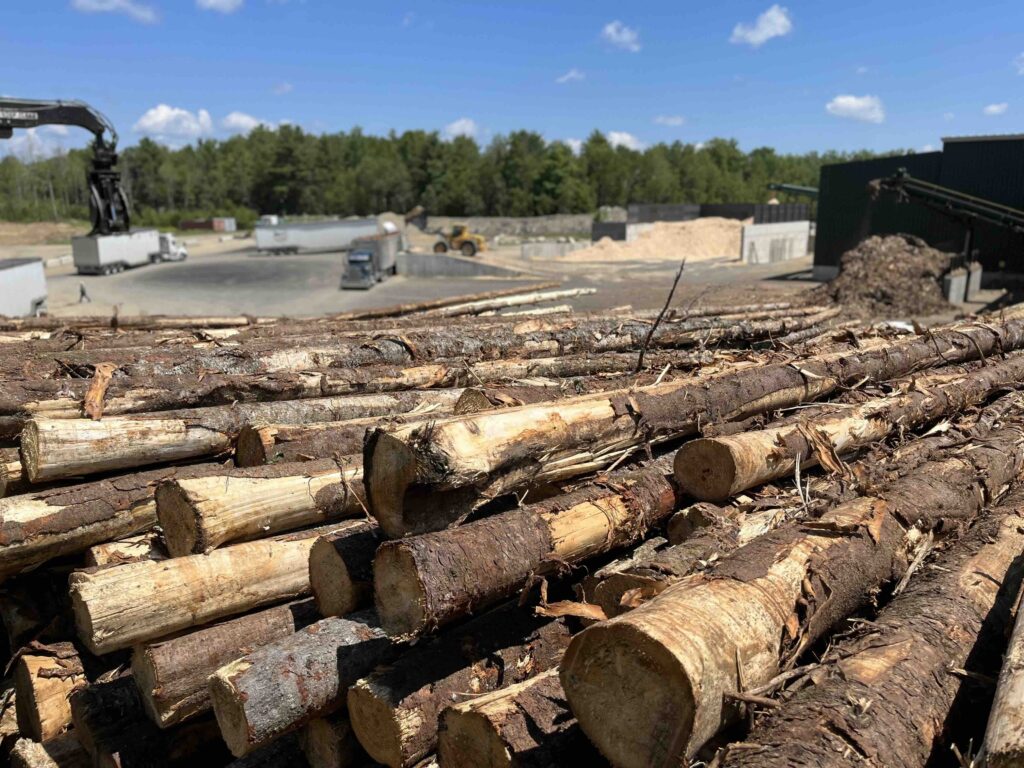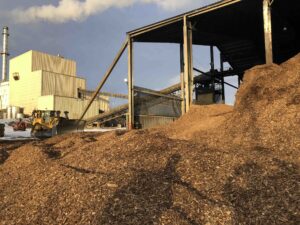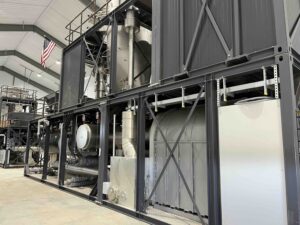Trends and Forecasts
Forest Industry Trends and Forecasts 2024
By Eric Kingsley

The forest industry across the Northeast is in a bit of a slump – things aren’t necessarily bad, but it certainly isn’t a time of expansion and profitability. This is a huge shift from a year ago when many markets were booming, mills were looking everywhere for wood, and the supply chain was stretched to its limits. Here’s a look at what is happening by sector.
Pulp and Paper
On the pulp and paper side, the last half of 2023 was marked by reduced demand, causing most mills to take downtime or other steps to reduce production. Talking to people who sell paper for a living, it looks like this reduced demand will continue, though looks to improve through the middle of 2024, as paper mills and their customers work through a backlog of paper in their warehouses. From most accounts, the worst is over, and we’ll see a gradual ramp-up in production as inventory of paper is sold and new demand drives production.
While some paper grades are doing better than others (as is almost always the case), this malaise is industry-wide. I’m seeing similar challenges in the Southeast, Lakes States, and Pacific Northwest. It is becoming clear that successful mills will have a diversity of paper grades that they can make, and for many moving away from printing and writing grades and into packaging or specialties has been critical to profitable operations. This is, of course, mill-specific, but the trend has been and will continue to be less paper that is used in communication (magazines, office paper, phone books, and newspaper inserts) and more that is used in packaging.
Some mills were able to use their downtime to make significant capital investments. ND Paper invested over $100 million in Rumford, and the SAPPI mill in Skowhegan is in the middle of a multi-year project to put over $400 million into that facility. This represents some very real optimism for the future and a belief that the markets will be there to support continued operation and capital recovery.
Lumber
After a couple years of historic highs in the lumber market (led by structural lumber, but everyone had a good run), we’re now in the “hangover” phase of the market cycle. High interest rates, which drive up what homebuyers pay on a monthly basis, have put the brakes on housing starts. This has an immediate impact on softwood lumber (used to frame new houses), but a few months later trickles into the hardwood markets, which see decreased demand for flooring, millwork, furniture, and other things that turn a house into a home.
On the softwood side, we have seen several mills take some brief downtime, or drop shifts. All of the spruce-fir mills I am aware of have low log inventories going into winter, and a few have expressed this is because they aren’t confident in near-term demand and pricing. I expect that the efficient mills will be fine during this current downturn, but recent increases in non-log costs will stress some facilities as they struggle in today’s market; hopefully those mills have cash left from the past boom market.
On the hardwood lumber side, things aren’t great either. Demand from both domestic and offshore markets is down. There are some signs that we will soon round a corner here, at least from some markets, with a number of mills telling me they expect their lumber markets to go from “horrible” to “bad” in the first half of 2024, and hoping for improvement from there.
One spot to watch is the market for residual chips, notably at paper mills. Obviously, a sawmill needs to move its chips in order to operate. This summer, as most paper mills slowed production, there were times when some sawmills had concerns about their ability to move all of their residuals. Things worked out in the end, in part aided by the fact that sawmills were curtailing their own production in reaction to slowing markets. The real issue here is, What happens if the lumber markets recover before the paper markets? At that point, an imbalance could be a problem.
It’s going to take a reduction in interest rates before we see widespread robust lumber markets again. Fortunately, recent data suggests that inflation is cooling, which should allow the Federal Reserve to slowly walk back interest rates. When this happens, pent-up demand for housing might quickly move us back to the “boom” part of a boom-and-bust cycle.
Biomass
Biomass power plants across the region (those that remain) continue to struggle with wholesale electricity costs that aren’t high enough to support profitable operations. Outside of winter months, when wholesale electricity prices get high as lower-cost natural gas is redirected to heating, it’s hard to make the numbers work for biomass plants.
For a number of stand-alone biomass power plants, I expect that we’re going to see them transition away from operating 24/7/365, (with some downtime for maintenance) to seasonal operations – running at capacity over the winter and parts of the summer, while idling during the low-demand electricity months in spring and fall. To keep their supply base intact, we’ll probably see year-round buying, though at a reduced pace and likely reduced prices. In fact, some plants are doing this already; they just aren’t being explicit about it.

The last months have seen a few big developments in biomass that will impact specific markets going forward:
• In Vermont, the Burlington City Council approved a plan to allow McNeil Station, a 50 MW plant within the city limits, to build a heat pipe to provide otherwise waste heat to a hospital. While there remain steps to complete, as long as this year-round heat user is connected to the biomass plant, it will improve both the efficiency and the economics of the biomass plant. It will also help support continued operations of the facility, and the important market for low-grade wood it provides.
• In New Hampshire, the state legislature failed to override Governor Sununu’s veto of a bill that would have delayed recovery of above-market costs associated with Burgess Biopower, a 75 MW biomass plant located in the northern city of Berlin. Given the high monthly payment this will require, coupled with a low electricity price, it is hard to see how the facility will continue to operate as it has for the past decade. There is the very real possibility of bankruptcy to reorganize and clear some debts; if that happens it will be interesting to see how that impacts future operations.
• In Maine, the Public Utilities Commission has a request for proposals for new, demand-located biomass generation up to 20 MW. After rejecting all proposals in a similar RFP last year, it is uncertain whether folks will apply, and if so, how those proposals will be received.
Emerging Products
We’re now seeing some movement toward new forest products. While paper and lumber will long be the dominant primary forest products produced in the Northeast, new products are starting to emerge.
• At the former paper mill in Madison, Maine, TimberHP is using softwood fiber to make insulation, a bio-based alternative to the pink stuff you can buy at every building supply store. Once fully operational, this plant will produce a range of insulation products (rolls, panels, loose) that compete with fiberglass and foam insulation.
• At least two firms have announced plans to produce biofuels from wood residuals. Ensyn, with over two decades of run-time at a facility in Ontario, has a financial partner with which to build a bio-oil plant at a former paper mill in Maine’s Katahdin Region. Down the road, Biofine has announced plans to build a production facility at the former Lincoln Pulp & Tissue site. Both of these companies plan to produce products that substitute for home heating oil, providing a local and renewable option for consumers.

• Biochar projects are underway in Greenville and Enfield, Maine, as well as efforts to do the same in Vermont, and probably elsewhere across the region. Biochar is wood heated in the absence of oxygen to produce a charcoal-like substance that can be used as a soil amendment in agriculture, as a filtering medium, and as a bulking agent in some cement and asphalt applications. These plants aren’t huge, and the market is in its earliest stages, but the carbon-storing qualities of biochar will likely only increase demand and the number of facilities in years to come.
• I am aware of people working to permit, and eventually construct, a plywood mill, an OSB manufacturing facility, and a cross-laminated timber manufacturing facility. While these aren’t new products (with the exception of CLT), new facilities provide new opportunities for landowners and loggers.
What’s driving these new facilities? For some, it is the culmination of years of work to get a project built. For others, the increased focus on products with a low (or even negative) carbon footprint, coupled with an increased recognition that manufacturing in the United States has benefits, presents a perfect opportunity.
Logging
For loggers, operating costs have spiraled upwards; the amount they are getting paid hasn’t always kept pace. The second half of this year was particularly tough in some areas, with wet weather combined with poor markets to reduce both the total and per-unit price loggers were getting paid.
The same high interest rates that have slowed the construction of new homes have also impacted the ability of loggers to re-invest in their operations. Logging equipment costs are high; coupled with high interest rates as many loggers are deferring new purchases. Of course, this will impact productivity and may be a constraint on supply when markets eventually rebound.
In Vermont, we saw a slowdown in logging after this summer’s catastrophic floods. Most loggers that own a dump truck, an excavator, or a dozer found work repairing roads and addressing flood damage. A few loggers told me this was a very profitable period for them, raising concerns that they might leave our industry and focus on dirt work.
In almost every part of the region, we’re seeing some logging contractors exit the industry (often aging out), and not enough new faces to fill behind them. Of course, there are efforts to address this challenge, but when we look at the age breakdown of today’s logging workforce it is clear that we’re going to need lots of new people to enter the industry; it’s not as clear where we’re going to find and train these people.
We have begun to see some change in business structure around logging (and trucking); this will continue. In Maine, some of the larger, well-capitalized logging firms are growing, leveraging their size to create opportunities for increased productivity. That may mean, in some areas, a few big firms and very few single-crew logging companies. We’re also seeing increased interest from mills, and to a lesser extent (so far) large landowners, in bringing logging and trucking in-house. I expect that loggers as independent contractors will remain the dominant business model, but don’t be surprised to see other parts of the supply chain enter this space, sometimes out of (perceived) necessity.
Workforce Challenges
It’s not just loggers that are having trouble finding workers. Everyone is: mills, landowner, the local coffee shop, everyone. In some ways this is a demographic challenge that has been coming for a while – rural areas are getting older, with a smaller percent of the population in their working years, or soon to enter the workforce. This suggests that the solution can’t just be “work hard to get the kids in the local high school to want to enter our industry,” a strategy that has long served the forest products industry. It suggests we, as an industry, are going to have to think more broadly: how do we attract new populations to the industry, and how do we make them welcome in rural communities? If the industry is going to thrive, we’re probably looking at a workforce that is more diverse and includes people who grew up somewhere else.
Summary
While this hasn’t been the greatest period for the forest products industry across the region, it hasn’t been horrible. Almost all large markets continue to operate, and we’re seeing investment, both in mills and in the supply chain. While predicting the future is perilous, especially in print, it does appear that we’re near the bottom of this cycle and markets will improve through 2024. The question at that point is whether the supply chain – particularly loggers and truckers – is robust enough to meet all of this renewed demand.
Eric Kingsley is a partner in Innovative Natural Resource Solutions LLC, and can be reached at [email protected]
